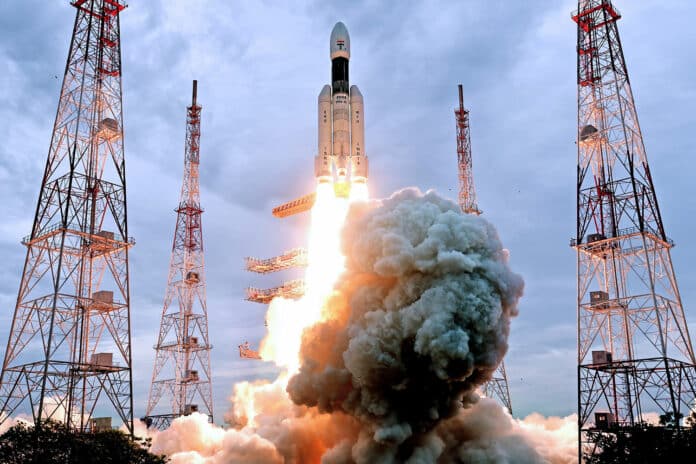India is on its way back to the Moon!
On 14 July 2023, Indian Space Research Organisation (ISRO) successfully launched its third mission, Chandrayaan-3, to the Moon.
The Launch Vehicle Mark-3 (LVM3) rocket with Chandrayaan-3 spacecraft was lifted off from the Satish Dhawan Space Centre in Sriharikota at 2:35 p.m. local time. About 16 minutes after liftoff, Chandrayaan-3 separated from the LVM3 as planned and entered the Earth’s orbit.
On 5 August 2023, ISRO achieved a Lunar-Orbit Insertion (LOI), successfully placing the Chandrayaan-3 spacecraft into orbit around the Moon. Just a day after, on Sunday, the space agency released the first images of the Moon as taken by Chandrayaan-3 spacecraft. The images show craters on the lunar surface getting larger and larger as the spacecraft draws closer.
Days after the release of the first images, on Thursday, they released two more images – one of Earth and another of the Moon – captured by a Lander Imager (LI) Camera.
Chandrayaan-3 is now at 1,437km at Apolune (the farthest point from Moon). Around 16 August, the spacecraft is expected to reach a 100 km orbit around the Moon, after which the Propulsion Module will separate from the lander for its landing approach.
The mission:
Chandrayaan-3 consists of an indigenous propulsion module, a lander module, and a rover. The lander and rover are expected to land close to the lunar South Pole on 23 August. It aims to safely and gently land on the lunar surface.
Upon landing, it will operate for one lunar day, which is approximately 14 Earth days.
Once on the Moon, Chandrayaan-3 will seek to explore the lunar surface in great detail, collect data and conduct a series of scientific experiments to learn more about the Moon’s composition.
The propulsion module:
The propulsion module carries the lander and rover from injection orbit to 100 km lunar orbit. Weighing 2,148 kg, the box-like structure has one large solar panel mounted on one side and a large cylinder on top that acts as a mounting structure for the lander.
The module also carries a Spectro-polarimetry of Habitable Planetary Earth (SHAPE) payload to study Earth’s spectral and polarimetric measurements from the lunar orbit.
The Chandrayaan-3 lander and rover:
The rover and lander are both similar in design to those from the Chandrayaan-2 mission. They are expected to operate for one lunar day (14 Earth days) to study their surroundings. The solar-powered robotic duo is not expected to survive a frigid night on the Moon.
The Chandrayaan-3 lander, ‘Vikram,’ is box-shaped, with four landing legs and four landing thrusters of 800 newtons each. It measures 2000 mm x 2000 mm x 1166 mm and weighs 1,752 kg, including the rover.
ISRO has incorporated major improvements in the lander for the mission. The space agency says they have upgraded the lander’s software and performed numerous tests to ensure it performs well under various circumstances. The legs on the lander have been strengthened compared to Chandrayaan-2 to help it survive a slightly high landing speed.
In addition to the rover, the lander carries various scientific instruments to perform in-site analysis. This includes Chandra’s Surface Thermophysical Experiment (ChaSTE) to measure the thermal conductivity and temperature of the lunar surface, the Instrument for Lunar Seismic Activity (ILSA) for measuring the seismicity around the landing site, and Langmuir Probe (LP) to estimate the plasma density and its variations.
The six-wheeled rover, Pragyan, measures 917 mm x 750 mm x 397 mm and weighs just 26 kilograms. It is powered by its own tiny solar array and guided by cameras to avoid obstacles.
The rover is armed with Alpha Particle X-ray Spectrometer (APXS) to analyze lunar soil and rocks and a Laser Induced Breakdown Spectroscope (LIBS) to zap its targets and derive their chemical composition.
LVM3-M4 launch vehicle:
India’s LVM3 rocket, the country’s heavy lift vehicle capable of placing about 8 metric tons into low-Earth orbit. This is the 4th operational flight of LVM3, which aims to launch the Chandrayaan-3 spacecraft to Geo Transfer Orbit (GTO).
If all goes according to the plan, India will soon become the fourth country to land on the Moon.
Rapid development and innovation have made space technology one of the most attractive sectors in India for investors. If all goes according to plan, the Chandrayaan-3 mission will help shape India’s role in future lunar exploration.
